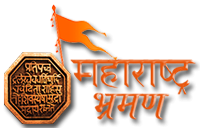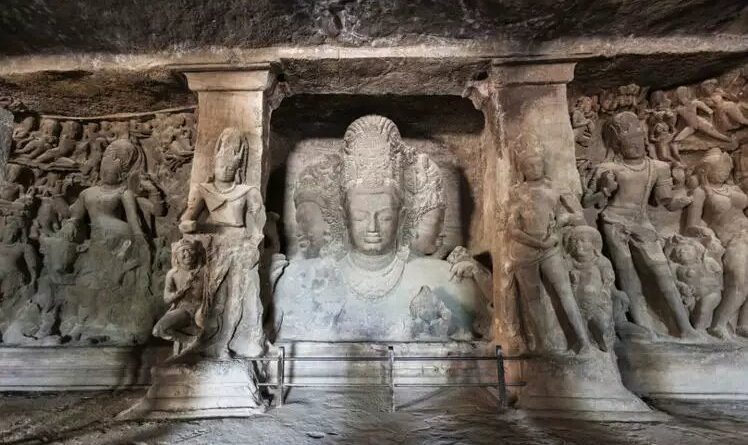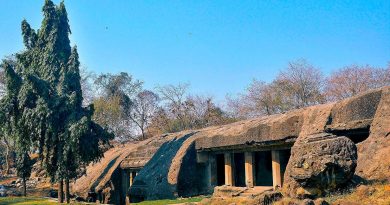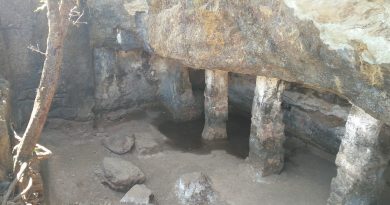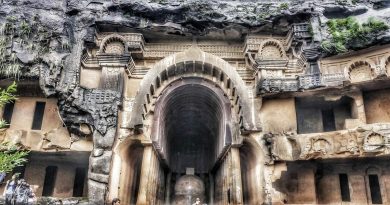Elephanta Caves
The Elephanta Caves are a network of sculpted caves located on Elephanta Island, or Gharapuri (literally “the city of caves”) in Mumbai Harbour, 10 kilometres (6.2 mi) to the east of the city of Mumbai in the Indian state of Maharashtra. The island, located on an arm of the Arabian Sea, consists of two groups of caves—the first is a large group of five Hindu caves, the second, a smaller group of two Buddhist caves. The Hindu caves contain rock cut stone sculptures, representing the Shaiva Hindu sect, dedicated to the god Shiva.
The rock cut architecture of the caves has been dated to between the 5th and 8th centuries, although the identity of the original builders is still a subject of debate. The caves are hewn from solid basalt rock. All the caves were also originally painted in the past, but now only traces remain.
The island was called Gharapuri and was a Hindu place of worship until Portuguese rule began in 1534. The Portuguese called the island Elephanta on seeing its huge gigantic statue of an Elephant at the entrance. The Statue is now placed in the garden outside the Bhau Daji Lad Museum (erstwhile Victoria & Albert Museum) at the Jijamata Udyaan (erstwhile Victoria Gardens) at Byculla in Mumbai. This cave was renovated in the 1970s after years of neglect, and was designated a UNESCO World Heritage Site in 1987 to preserve the artwork. It is currently maintained by the Archaeological Survey of India (ASI).
Main cave:
The main cave, also called the Shiva cave, Cave 1, or the Great Cave, is 27 metres (89 ft) square in plan with a hall (mandapa). At the entrance are four doors, with three open porticoes and an aisle at the back. Pillars, six in each row, divide the hall into a series of smaller chambers. The roof of the hall has concealed beams supported by stone columns joined together by capitals. The cave entrance is aligned with the north-south axis, unusual for a Shiva shrine (normally east-west). The northern entrance to the cave, which has 1,000 steep steps, is flanked by two panels of Shiva dated to the Gupta period. The left panel depicts Yogishvara (The Lord of Yoga) and the right shows Nataraja (Shiva as the Lord of Dance). The central Shiva shrine (see 16 in plan below) is a free-standing square cell with four entrances, located in the right section of the main hall. Smaller shrines are located at the east and west ends of the caves. The eastern sanctuary serves as a ceremonial entrance.
Each wall has large carvings of Shiva, each more than 5 metres (16 ft) in height. The central Shiva relief Trimurti is located on the south wall and is flanked by Ardhanarisvara (a half-man, half-woman representation of Shiva) on its left and Gangadhara to its right, which denotes river Ganges’s descent from Shiva’s matted locks. Other carvings related to the legend of Shiva are also seen in the main hall at strategic locations in exclusive cubicles; these include Kalyanasundaramurti, depicting Shiva’s marriage to the goddess Parvati, Andhakasuravadamurti or Andhakasuramardana, the slaying of the demon Andhaka by Shiva, Shiva-Parvati on Mount Kailash (the abode of Shiva), and Ravananugraha, depicting the demon-king Ravana shaking Kailash.
The main cave blends Chalukyan architectural features such as massive figures of the divinities, guardians, and square pillars with custom capitals with Gupta artistic characteristics, like the depiction of mountains and clouds and female hairstyles.
Layout:
Main Hall
1. Ravana lifting Kailash
2. Shiva-Parvati on Kailash
3. Ardhanarishvara
4. Trimurti
5. Gangadhara
6. Wedding of Shiva
7. Shiva slaying Andhaka
8. Nataraja
9. Yogishvara
16. Linga
East Wing Shrine
10. Kartikeya
11. Matrikas
12. Ganesha
13. Dvarapala
West Wing Shrine
14. Yogishvara
15. Nataraja
Main cave shrine:
The central shrine is a free-standing square cell, with entrances on each of its sides. Each door is flanked by two dvarapalas (gate keepers). The Linga, the symbol of Shiva in union with the Yoni, and the symbol of Parvati together symbolise the supreme unity that is deified by the shrine. The Linga is set on a raised platform above the floor of the shrine by 6 feet (1.8 m). Six steps lead to this level from the floor level. The height of the eight dvarapalas varies from 14.833–15.167 feet (4.521–4.623 m). All are in a damaged condition except those at the southern door to the shrine. The southern gate statue has many unusual features – an unusual headgear; a large skull above the forehead; lips parted with protruding teeth; statues adorned with a single bead necklace, earrings, plain twisted armlets and thick wrist-lets; a stooped right shoulder; a globe held at navel level; the robe is held at the right thigh by the left hand, and the legs are shapeless.
East wing:
Several courtyards to the east and west of the main cave are blocked, though there is a 55 feet (17 m)-wide courtyard that is accessible by entering the eastern part and climbing nine steps. A temple on the southern wall of the court depicts a well-preserved fresco. The circular pedestal seen in the courtyard in front of the Shiva’s shrine near the east end, in the open area, is said to be the seat of Nandi, Shiva’s mount.
On each side of the steps leading to the temple-cave portico is a winged lion, or leogriff, each seated with a raised forepaw. The portico has chambers at each end and a Linga-shrine at the back. Five low steps and a threshold lead into the central Linga-shrine which is 13.833 feet (4.216 m) wide and 16.0833 feet (4.9022 m) deep and has a circumambulatory path (Pradakshina-path) around it. At the back of the portico, near the east end, is a gigantic statue of a four-armed doorkeeper with two attendant demons. At the north end is a standing figure holding a trident. His left hand rests on a defaced demon-figure. The west wall depicts the Ashta-Matrikas (eight mother goddesses), flanked by Kartikeya and Ganesha, the sons of Shiva. Some of Matrikas are depicted with children, but all of them are shown by their respective mounts (bull, swan, peacock, a Garuda, etc.) which identify them. At the east end of the portico is another chapel with a plain interior and sunken floor. Water drips in this chapel.
West wing:
The west wing, entered through the main cave, is in a semi-ruined state. It has a small chapel and a cistern enclosed within the pillared cave, which is believed to be Buddhist. Another shrine to the west of the courtyard, with a portico, has carvings of Shiva in a yogic pose seated on a lotus carried by “two fat, heavy, wigged figures”. This carving also depicts a three-faced bearded Bramha and several other figurines. Entering through the back door of the portico is a cave enshrined with a multifaceted Shiva Linga erected over roughly hewn salunkhs. At the door entrance on both flanks, statues of gatekeepers standing over demons and two fat, poised figures are seen. On the southern side of the door, is an ensemble of a number of statues. Prominent among these is the Shiva carving, which is depicted with six arms and the third eye in the forehead. Though in a partly ruined state, the carving shows Shiva with an ornamented crown fixed with a crescent, seen carrying a cobra in the left hand, a club in another hand, and discerned to be in a dancing pose. Next to this image are a figure under a plantain tree and a Shiva image (Yogishvara) seated on a lotus. Also seen in the panel are a male figure riding a bull with a bell fastened to its neck, a female figure and another carving to left of Shiva, a female figure with a jewel on her forehead with neatly looped head-dress, Indra riding an elephant, Vishnu with four arms, holding a discus in one of his left hands and riding on Garuda flanked by a small flying figure, and a male figure with crescent in his hair.
How to Reach:
1.Take the local and reach Churchgate Station by 08:15.
2.a taxi (it’s a 5-minute ride) to The Gateway of India.
3.Book tickets on the 09:00 ferry to Elephanta Island. Tickets are priced at Rs. 120 a head (return journey included) and can be bought at the counters near the entrance to The Gateway of India. You need to pay an extra Rs. 10 to sit on the top deck.
4.Reach Elephanta Island by 10:15.
5.Explore the ruins at your leisure. Don’t forget to trek up to Cannon Hill. It’s worth it.
6.Catch the 13:00 ferry back and reach The Gateway of India by 14:15.
7.Have a scrumptious buffet lunch at The Taj Mahal Palace & Tower (approx. Rs. 1100 per head).
8.16:00 – Catch the local back to your area.
